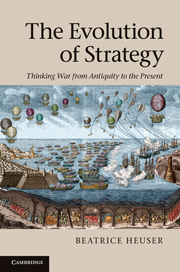Book contents
- Frontmatter
- Contents
- Acknowledgements
- A note on referencing
- Part I Introduction
- PART II Long-term constants
- PART III The Napoleonic paradigm and Total War
- PART IV Naval and maritime Strategy
- PART V Air Power and nuclear Strategy
- PART VI Asymmetric or ‘small’ wars
- PART VII The quest for new paradigms after the World Wars
- 17 Wars without victories, victories without peace
- 18 No end of history: the dialectic continues
- 19 Epilogue: Strategy-making versus bureaucratic politics
- 20 Summaries and conclusions
- Bibliography
- Index
20 - Summaries and conclusions
from PART VII - The quest for new paradigms after the World Wars
Published online by Cambridge University Press: 05 June 2012
- Frontmatter
- Contents
- Acknowledgements
- A note on referencing
- Part I Introduction
- PART II Long-term constants
- PART III The Napoleonic paradigm and Total War
- PART IV Naval and maritime Strategy
- PART V Air Power and nuclear Strategy
- PART VI Asymmetric or ‘small’ wars
- PART VII The quest for new paradigms after the World Wars
- 17 Wars without victories, victories without peace
- 18 No end of history: the dialectic continues
- 19 Epilogue: Strategy-making versus bureaucratic politics
- 20 Summaries and conclusions
- Bibliography
- Index
Summary
The first chapter of this book listed a series of questions which have been addressed along the way, but overall answers must be given now, based on the findings of this book.
From antiquity to the Thirty Years War, and again in the age dominated by the Napoleonic paradigm, most writers on war assumed that it is an inevitable part of the world. Many sought ways to limit it, and a few, writing especially in the Enlightenment and again in the twentieth century, even hoped that it could be abolished altogether through binding legal arrangements and restructurings of societies. The abolitionists and the limiters met in making efforts to reduce the pain and suffering caused by war. Some merely sought ways to offset their own side’s weakness, like some maritime strategists of secondary powers. Several Roman Catholic thinkers like Bonet in the fourteenth century and Hay du Chastelet in the seventeenth, as well as Moltke and the other ‘realists’ and Social Darwinists from the mid nineteenth century onwards, not only dismissed alternative solutions to war but positively welcomed it as part of God’s or Nature’s great design. They tended to favour battles and the offensive. As we might expect, the limiters largely advocated defence, deterrence and indirect approaches to reaching one’s goal. Complicating the picture, however, some limiters advocated seizing the initiative by instigating offensive and decisive battles, or using terror, including the bombing of cities, in the hope of offsetting their own perceived weakness or shortening the war. Both sides were driven by their view of the world and their ideologies. Technology could generally be used to defend arguments on either side.
- Type
- Chapter
- Information
- The Evolution of StrategyThinking War from Antiquity to the Present, pp. 500 - 505Publisher: Cambridge University PressPrint publication year: 2010



